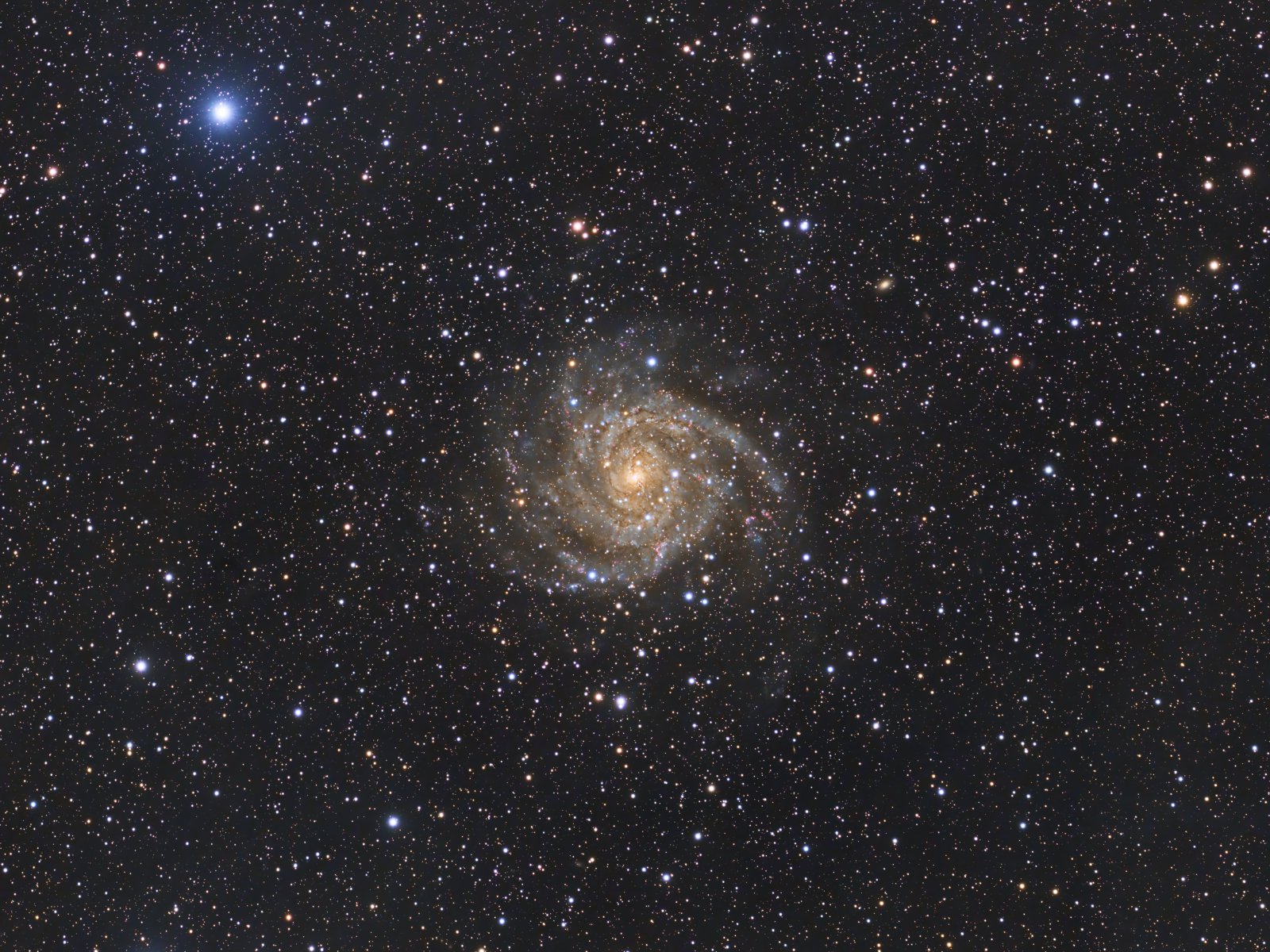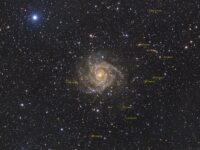IC 342, the Hidden Galaxy
 Click image for full size version
Click image for full size version
December 28, 2022
This is IC342, a face-on spiral galaxy in Camelopardalis, in the far northern sky. It is large in the sky, at about 2/3 the width of the moon, though it lies about 11 million light years away. It is a challenge both to observe and to image because it lies almost the plane of the galaxy, and is obscured by a lot of dust from the arms of our own Milky Way galaxy. For this reason, it is sometimes called the “Hidden Galaxy.” Overall, it appears more red than other galaxies I’ve imaged due to the dust. This image also shows off many pinkish H-alpha regions dominated by glowing hydrogen gas, as well as lots of dark, dusty lanes in the arms of the galaxy. There are several other galaxies in the field that are much more distant; see the annotated image.
Tekkies:
Acquisition, focusing, and control of Paramount MX mount with N.I.N.A., TheSkyX; unguided. Focus with Optec DirectSync motors and controller. Equipment control with PrimaLuce Labs Eagle 4 Pro computer. All pre-processing and processing in PixInsight. Acquired from my SkyShed in Guelph. Average transparency and seeing. Acquired November 23 to December 5, 2022, mostly under a moon-free sky except for Ha, acquired with moderate moonlight.
Sky-Watcher Esprit 150 f/7 refractor and QHY600M camera with Optolong UV/IR and 3nm H-alpha filters
Tak FSQ-106 @ f/5 (530mm), QHY-367C Pro One-shot colour, Optolong UV/IR filter
46x5m Ha = 3hr50m
159x5m OSC = 13hr15m
Preprocessing: The WeightedBatchPreProcessing script was used to perform calibration, cosmetic correction, weighting, registration, local normalization and integration of all frames.
Alignment of Master Frames: DrizzleIntegration was applied to the OSC frames (within WeightedBatchPreProcessing), and the result was aligned to the Luminance master with StarAlignment. This yielded aligned Ha, Lum and Colour masters.
Gradient Removal: DynamicBackgroundExtraction was applied to the three masters.
Colour Calibration: ColorCalibration was used to calibrate the OSC master.
Deconvolution: BlurXterminator was used on each master with a custom psf FWHM determined with the PSFImage script, and star sharpening set to 0.08.
Linear Noise Reduction: NoiseXterminator was applied to each image with settings Amount=0.9 and Detail=0
Stretching: HistogramTransformation was applied to each image to make a pleasing yet bright image.
Combining Luminance, Colour and H-alpha Images
Luminance addition: LRGBCombination was applied to replace the lightness of the RGB image with the Luminance master.
H-alpha Blending: With a mask in place to select only the galaxy, PixelMath was used to add the H-alpha to the LRGB image (the target image, $T) as follows:
R: max($T[0], 1.6*Ha)
G: $T[1]
B: iif($T[0]<Ha, $T[2] + 0.08*Ha, $T[2])
Additional Processing
Star Removal: StarXterminator was used to remove the stars.
Nonlinear Noise Reduction: NoiseXterminator was used to reduce noise in the background areas of the image with settings Amount=0.9 and Detail=0.3
Contrast Enhancement: LocalHistogramEqualization was applied three times using an inverted lightness mask to protect the background and select the galaxy. A Contrast Limit of 1.5 and 1 iteration were used for each application (scale 40, strength 0.25; scale 100, strength 0.25; and scale 150, strength 0.18).
Sharpening: MultiscaleMedianTransform was used to sharpen Layers 1 – 5 with strengths of 0.03, 0.05, 0.05, 0.04, and 0.03, respectively.
Star Restoration: Stars removed using StarXterminator were added back into the image using straight addition in PixelMath. The star image was used as a mask to shrink the stars slightly using MorphologicalTransformation (morphological selection mode, selection=0.11, strength =0.5, star shape 5×5 round).
Final Steps: Background, galaxy and star brightness, contrast and saturation were adjusted in several iterations using CurvesTransformation with masks as required. ICCProfileTransformation (sRGB IEC61966-2.1; Relative Colorimetric with black point compensation) was applied prior to saving as a jpg.








Wow! Spectacular! Thanks for a great astrophoto and informative write-up.
Terrific shot Ron. Definitely worth a visual hunt!
Thanks.
Thank you sharing this great image of an object that is impossible for me to observe from my southern hemisphere location! And thank you for the in depth write up regarding the processing using PI. What scope perfomed what task? I guess The 150 for lum and Ha? And the Tak for OSC?
Yes, as shown in the notes.
Enhorabuena Ron. Tanto la foto como las explicaciones de cómo la tomaste y procesaste son excelentes. Muchas gracias por compartir tu trabajo.
Gorgeous image, like always!
Excellent work!